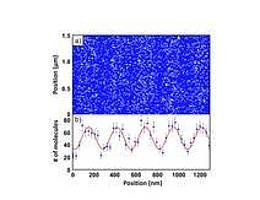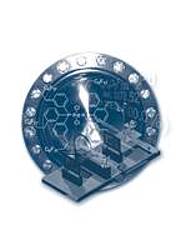Introduction
Three Nobel Prizes in quantum and atom optics (1997, 2001 and 2005) have paved the way and motivated EuroQUASAR. These achievements have contributed to the development of methods to cool and trap atoms with laser light; achievement of Bose-Einstein condensation in dilute gases of alkali atoms; and, development of laser-based precision spectroscopy, including optical frequency comb technique. “Quantum standard” stands for future optical clocks, inertial sensors of unprecedented precision and novel fundamental tests based on atomic, molecular or mesoscopic quantum systems with well defined, unique and eternal features.
Collaborative Research Projects of EuroQUASAR focus on the following topics:
Highlights
The most recent contribution by the Vienna group around Markus Arndt now demonstrates for the first time the use of that principle for precise quantum interference lithography with molecules: When molecules traverse an arrangement of two gratings, their quantum wave behavior leads to the formation of nanostructured fringes – with fringe periods of about 250 nm – which can be captured on a surface.
Pushing the limits of matter wave interferometry
Research on matter waves is a thriving field of quantum physics, currently pursued by many research groups around the world both for elucidating questions on the foundations of quantum physics and for developing new methods for precision measurements. Researchers of EuroQUASAR-MIME are currently holding the world record in what concerns particle mass, molecular chain length and complexity for matter wave interferometry. The increased molecular complexity is associated with more possibilities to couple the quantum system, i.e. the molecule, to its environment. This offers new handles for studying decoherence, i.e. the apparent loss of quantumness, in new ways: Molecules may be internally as hot as fire, while still showing full quantum behavior in their center of mass motion. Moreover, even at equal mass, two molecules may have a different internal conformation, chemical structure, handedness, temperature, electric or magnetic moment.
New Atomic Quantum Sensors for ultra-precise monitoring of accelerations and rotation
Atomic Quantum Sensors are a key-technology for the ultra-precise monitoring of accelerations and rotations. These sensors evolved out of a new kind of optics based on matter waves rather than light waves. Euroquasar advances research at the frontiers of matter wave interferometry by supporting of a worldwide collaboration on Inertial Quantum Sensors (IQS). IQS strengthens research on a variety of novel sensors at the state-of-the-art and supports the launch of novel devices. LUH, SYRTE, HUB and UNIFI are working on of the next generation of sensors aiming at an improvement in sensitivity by one or two orders of magnitude. The quantum gyroscopes at the LUH was enlarged by more than one order of magnitude in area to a long base-line interferometer which will shorten by at least two order of magnitude the integration time. The start of the construction of a novel quantum gyroscope at SYRTE aims to further improve this performance within the next three years. Several gravimeters are in operation or under construction at HUB, SYRTE and UNIFI. A comparison campaign is prepared at SYRTE to analyse atomic gravimeters. IQS aims to improve current state of the art by one to two orders of magnitude in accuracy. Novel methods for atomic quantum sensors were reported by various groups and can be found soon at the webpage of IQS. Robust and transportable sensors operated in the extended free fall represent the most ambitious part of these activities and aim for unprecedented sensitivities.




